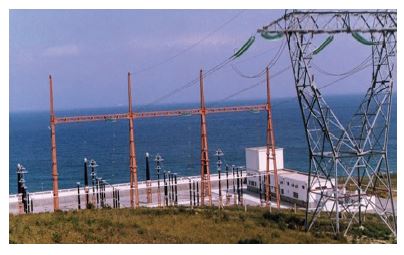By Costis Stambolis* As work is in progress on the electric tie up between mainland Greece and the island of Crete, following completion in January of the first leg of the project with the laying of an underwater cable, the foundations have been laid for what will soon become a giant electricity arc spanning across half the Mediterranean Sea.
As work is in progress on the electric tie up between mainland Greece and the island of Crete, following completion in January of the first leg of the project with the laying of an underwater cable, the foundations have been laid for what will soon become a giant electricity arc spanning across half the Mediterranean Sea.
The mainland to Crete electricity interconnection comprises two separate underwater cables, the small 132 km AC interconnection now completed, and the longer AC/DC of some 328 km underwater and 30 km overland, which is soon to be laid.
The design and construction of both cables has been undertaken by a subsidiary of Greece’s Independent Power Transmission Operator (IPTO), known as Ariadne SA. Once completed, Crete will be linked to Greece’s mainland grid, thus improving its security of energy supply while enabling the retirement of several aged and highly polluting diesel power generating plants operated by PPC.
At the same time, the interconnection will facilitate the expansion of solar parks and wind farms as their output will no longer be limited by island grid constraints thus opening the way for Crete to utilise its huge renewable energy potential.
But the mainland Greece-to-Crete interconnection is not where the story ends. Rather, this is where it begins since we now have in the making the far longer and more complex electricity interconnection between Crete and Cyprus and then from Cyprus to Israel.
The overall aim of which is to put an end to Cyprus’s energy isolation since it is the only European country which remains unconnected to the extended European electricity grid.
This highly ambitious project has been quietly developed over the past nine years by Nicosia based EuroAsia Interconnector and is fully backed by the EU through its Project of Common Interest (PCI) programme. Through this programme and other resources, the project has already received funding to the tune of about ?20 million for a whole range of studies, including the front-end engineering design (FEED).
A major milestone in the project’s development was reached last July when the Republic of Cyprus issued the final building permit to EuroAsia Interconnector for the construction of the high voltage direct current (HVDC) converter station in Cyprus.
The permit gives the green light for the construction of the 1,000MW converter station, to be built by Siemens, as well as the landing point facilities of the subsea cables that will connect the electricity networks of Cyprus and Israel with Greece (Crete) and the EU. Following that and as the project progresses, we shall see the start of construction of similar converter stations in Israel and Crete.
It is worth recapping the technical characteristics of this most challenging regional energy infrastructure work. The project consists of a 500kV DC underwater electric cable and any essential equipment for interconnecting the Cypriot, Israeli and the Greek (via Crete) transmission networks (offshore).
At its full deployment (Stage 2), the project will have a capacity of 2000 MW and a total length of 820 nautical miles (330 km between Cyprus and Israel, 880 km between Cprus and Crete and 310 km between Crete and Attica) and allow for bidirectional transmission of electricity. The laying depth of the cable in some areas between Israel and Cyprus is expected to reach 2,200m, while the respective depth in some areas between Cyprus and Greece will reach 3,000m.
Phase one of the project will involve a transmission capacity of 1000MW, with the total construction cost estimated to reach ?2.5 billion. If we were to add the ?1.0 billion of the Attica-Crete interconnection now under construction, the total cost of the Greece-Cyprus-Israel electric cable project exceeds ?3.5 billion and thus makes it the most expensive single infrastructure project ever built in the region.
Furthermore, the EuroAsia Interconnector will be given a big boost over the next few weeks in view of the signing of the now imminent trilateral agreement between Cyprus, Israel and Greece which will finalise operational details, but also provide a much needed political backing. Commissioning of the Cyprus-Crete interconnection and the Israel-Cyprus interconnection is scheduled for December 2023.
This highly ambitious project, with a total length 1208 km, once completed, will open up new energy avenues in the region by providing alternative electricity transmission channels and contributing to the region’s energy security. In this sense, the project, a huge electric arc spanning across the East Mediterranean, has great geopolitical importance as it will further contribute to the energy and security cooperation of the three countries involved.
*By Costis Stambolis for Financial Mirror (27/2-5/3/2021)




